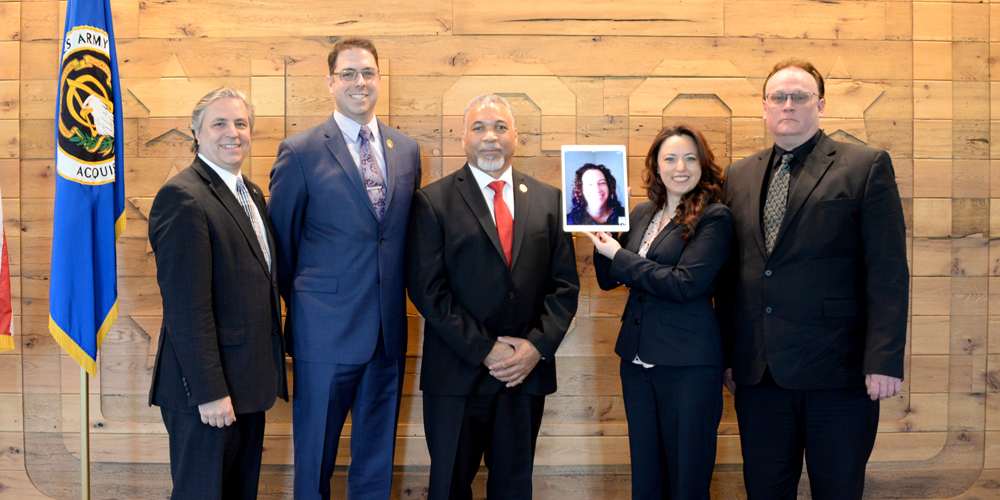
FORT BELVOIR, Va. (April 25, 2014) – Five members of the 2014 Competitive Development Group/Army Acquisition Fellowship (CDG/AAF) were recognized at a graduation ceremony April 18, marking their completion of the three-year developmental program that provides expanded training through a series of educational, leader development and broadening assignments for members of the Army acquisition workforce.
“This is a great day to celebrate achievements in the Army,” said Craig Spisak, director of the U.S. Army Acquisition Support Center (USAASC) and host for the ceremony. Spisak was a member of the very first CDG/AAF program, and recalled his experiences from nearly 20 years ago.
“In April 1997, I got that call and was very excited to join the ranks of what I thought was going to be and has now subsequently proved out to be one of our premier leader development programs,” he said. “It’s an honor to be here because I’ve walked in your shoes to some degree.”
Since its inception, the program has provided board-selected individuals with essential leadership training and developmental assignments to better position them for future selection into critical acquisition and key leadership positions.

CDG/AAF graduate David Oatley noted that the program’s diverse experiences helped him to “see the bigger picture.” (U.S. Army photos by Ashley Tolbert)
In his remarks, Spisak stressed the importance of building relationships. “As you progress, remember that the vast majority of the things you do becomes less and less important about how smart you are and how good you are, and more about your personal relationships with other people.”
He also advised the graduates to remember the importance of trust, professional conduct and preserving one’s reputation. “At the end of the day, those will all come back to whether or not people trust that you’ve done the legwork, you’re prepared and what you say has some bearing and meaning and that they know you’ll stand by your word.”
Those selected for CDG/AAF have their choice of two distinct tracks: program management or acquisition leader.
Participants who pursued the acquisition leader track came from such fields as systems engineering, contracting and logistics. The acquisition leader track offers fellows broadening assignments within their acquisition career fields (ACFs) and opportunities to gain experience in other ACFs. The program management track features developmental assignments as well as posts as an assistant product manager, DA systems coordinator and other developmental program management positions.
“This program gives you the opportunity to take [rotational] assignments and experience the different functions that you may be interested in and learn more,” said David Oatley, one of the graduates and project officer for the Gator Landmine Replacement Program at the Program Executive Office for Ammunition.

Timothy Goddette, deputy program executive officer for Soldier and guest speaker, highlighted the value of the CDG/AAF program. “This is a program we need because of the opportunities it provides you to develop yourself,” he reminded the graduates.
The 36-month timeline provides a series of diverse experiences and rotations similar to military counterparts. “In three years, we’ve been able to accomplish what may take 5, 10 or 15 years for some,” said Oatley.
And from his perspective, the time was well worth it. “[This program] will help us be more effective for the Army in general and also get more satisfaction from our own careers and personal growth,” he said.
Timothy Goddette, deputy program executive officer for Soldier and guest speaker, highlighted the value of the program and what it says about the people who complete it. “This is a program we need because of the opportunities it provides you to develop yourself.”
Goddette outlined three key components that best describe the benefits of the program: competition, in that those who are selected are “among the best” in the Army Acquisition Workforce; development, an important component for those who don’t know exactly what’s next in their careers but strive to grow and be challenged; and networking and staying connected, critical to being effective.
“That’s the key: being able to get people to focus on a common goal to get something done for our Soldiers,” he said.

Lauren Johnsky was not able to attend the graduation ceremony in person, so the team at the U.S. Army Acquisition Support Center found a way to have her there virtually.
Out of 17 graduations, this was the first where one of the graduates participated virtually. “Attending over the screen was much like being there in person,” said Lauren Johnsky, who was unable to get to Fort Belvoir for the event. “My favorite moment was having my photo taken with everyone! I felt completely included.”
For those interested in applying for the program, Johnsky and Oatley have some advice.
“The effort you put in is the reward you will gain from it,” said Johnsky, a program support specialist at the U.S. Army Communications-Electronics Research, Development and Engineering Center. “I also think that it’s absolutely imperative to use the opportunity to get out of your comfort zone and meet new people.”
For Oatley, recognizing the need to take charge of his own career was a key factor in pursuing the CDG/AAF program. “There are opportunities and I think the Army does a fantastic job at making things available. So if you’re not taking advantage of [those opportunities], that’s on you. You can’t just sit back and think that if you do a good job, things will happen—because it doesn’t.”
Applications for the next year’s class will be accepted beginning Aug. 15.

Craig Spisak, left, director of USAASC, hosted the graduation ceremony marking completion of 17th Competitive Development Group/Army Acquisition Fellowship Program at Fort Belvoir on April 18. With Spisak are fellows David Oatley, Mo Stephens, Lauren Johnsky (who attended virtually), Monica Clemons and Walter Hamm Jr.
Read the full article in the Spring 2021 issue of Army AL&T magazine.
Subscribe to Army AL&T – the premier source of Army acquisition news and information.
![]()







